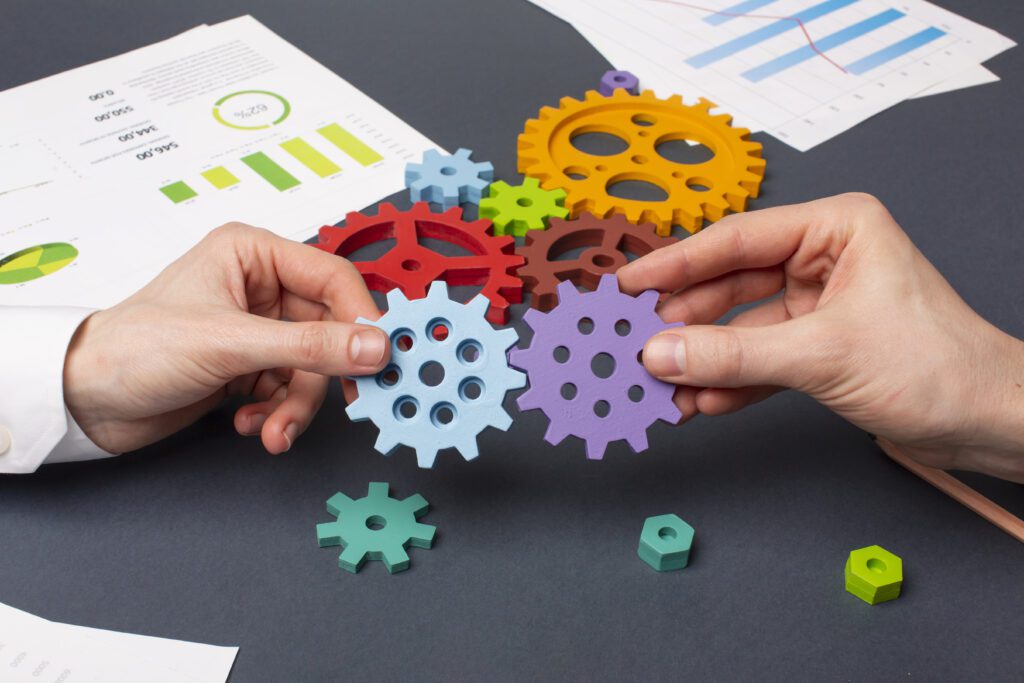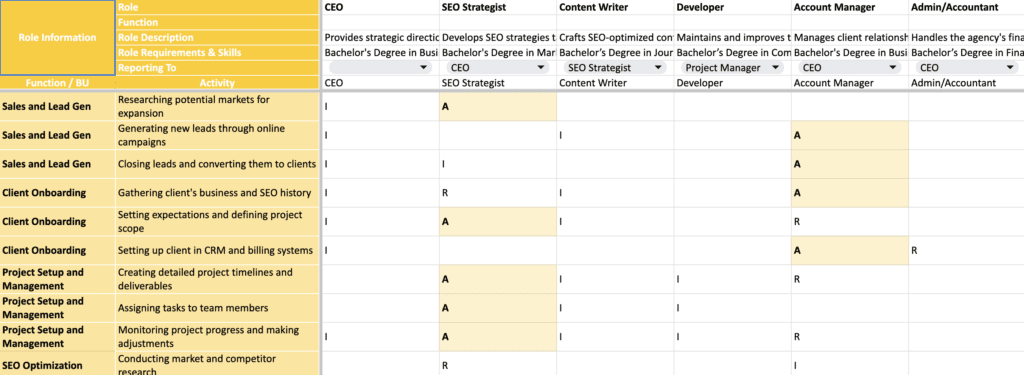
Your org structure is an important piece of your business. It defines who reports to whom, and which topics get which attention.
But an org structure alone is really just a piece of paper. A few boxes connected by lines.
So how do you bring your org structure to life?
You got to derive your operating model. Your operating model describes how your team executes your strategy and delivers value.
Essentially, it translates your org structure into the way you work.
This blog post shows you how to define your operating model from your org structure.
Describe your strategy
Before diving into org structure and operating model, you need to understand your goals and strategy. Your strategy will guide all decisions after.
As a minimum, your strategy should include the following:
- Revenue and sales targets for a 1-5 year time horizon (where do we want to be)
- Clear offering structure for your products or services (what do we play)
- Clarity about your markets and channels (where do we play)
- Precisely spelled out USP and value proposition, as well as positioning (how do we win)
Read more about what org structures work best in complex environments here.
Define your Org Structure
Once you know where you are going, you can define your org structure.
At any point, you will have an org structure in place, either intentionally defined or de-facto.
Your goal at this stage is to define your target org structure.
What’s a target org structure
Your target org structure describes what your team will look like to reach your goals. Think about it as a future version of your business, that’s capable of operating at the level you have defined as a goal.
That structure might look much like today’s, or it can look much different. That depends on how big the gap between today and your strategic goal is.
Let’s develop your operating model. Book a free consultation here.
From simple structure over functional to advanced structures
All businesses start out with a simple structure. A simple org structure is characterized by everyone in the business reporting to you as the CEO.
The next step of evolution is typically a functional structure, where you build departments around functions, like Sales and Marketing, Operations, and Admin/Finance.
After that, most organizations develop into more advanced structures like divisional structures, pod or team structures or matrix structures.
See an overview of different forms of organizational structures here.
Define Responsibilities
Now we’re moving into defining your operating model. To marry your org structure with the way you operate, you need to define what each role is supposed to do.
The best tool to do that is the RACI Matrix.

Here’s how to do it:
- List all your processes in a spreadsheet as rows
- List all your roles in a spreadsheet as columns
Now go through the list of processes and define for each process who’s involved in which way. The options are:
- A for Accountable: There needs to be exactly one person who owns a process. Think about this person as the one you would go to if a process is not working well or the results aren’t good.
- R for Responsible: These are the people who actually do the work. It can be one or more than one, and it can also be the same person that’s accountable.
- C for Consulted: This is a person that’s being asked for input for a specific process
- I for Informed: This person is merely informed about a process being performed or its results.
This is a fantastic exercise to develop a consistent structure of “Who’s doing what.” All tasks are covered, nothing falls through the cracks.
Based on the RACI matrix you can develop the team’s job description. Have a 1:1 session with each team member to discuss the job description and align on expectations for the role.
Check a more detailed guide on how to use the RACI matrix to develop job descriptions here.
Define Processes
In the last step you have already built a list of all your processes. The next crucial step in developing your operating model is to define all your processes, policies and procedures in detail.
Work with your team to map and document everything that you do. The level of detail depends on a variety of factors, such as:
- Autonomy of your team
- Complexity of your processes
- How repetitive your processes are
Collect your processes in a wiki or another central repository.
Define Tech and Tools
Next, you want to look at the tools your team uses to execute their work.
Your Tech Stack
This will include your tech stack, like task- and collaboration-software, ERP systems, special software you need for your industry, as well as communication tools like chat, video-calls and email.
Map your tech stack along your processes. Clearly define what tool is used for what. And specifically, define what tools should not be used for. (A prime example is that you don’t want your project or client related communication buried in your general slack channel)
Other tools
Also, consider other tools beyond tech.
Examples include templates or reports. Anything that is consistently used and a central part of how you operate is part of your operating system. Link and mention these tools in your process descriptions.

Define Decision-Making and Communication
A vital part of defining your operating system is deciding on communication channels and decision-making.
Communication channels
How effectively information flows through your business will determine how well your team can drive growth.
With your org-structure, processes and tech in place, check your operating systems for gaps you need to close: Are there people that should talk regularly?
Are there information needs that are not covered by your tech stack or reports?
Where that’s the case, develop communication structures that bridge these gaps. These could be regular meetings. Or asynchronous forms of communication like dashboard, reports or regular updates via email/chat.
Decision-making
Your team needs clarity on what decisions they can make, how to be involved and what decisions need to be approved by management.
You can specify that either in the job descriptions, in the process descriptions, or as a stand-alone documentation.
As a rule of thumb, you want to find your version of the rule “as autonomous as possible, as hierarchical as necessary”.
There will be things you happily delegate, others you want to have run by you before they’re decided.
Even if you can’t delegate a type of decision (e.g. purchasing) fully, consider using decision-making thresholds. All decisions below a certain threshold can be made by your team, beyond the thresholds they need approval from you or someone else.
Management System
Lastly, you need to define your management system. While the scope of this will look different for every business, some components that are worth considering are:
- Target setting: The way you set goals for your team. Closely connected to strategy execution.
- Key Performance Indicators (KPIs): The metrics you and your team optimize for.
- Ongoing strategy evaluation
Your Operating Model
With all these items in place, you have defined your operating model. Congrats.
You’ll find that some items are not as important for you, while you will add others.
The bottom line is: Your team needs high clarity on what goals you want to achieve, and how they’re supposed to reach them.
The operating model is your way of expressing that.